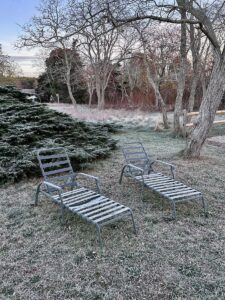One of the things I love most about living here is being more in tune with nature’s rhythms. Watching tides, Moon phases, storm systems, and bird migrations, I’ve learned to use my senses to notice the daily shifts as the season changes. That said, I must have looked away briefly last week because I was the unwitting victim of what I term Seasonal Denial Syndrome, or SDS.
Early October was a second summer. I could garden barefoot and even took off my sweatshirt to plant bulbs and feel the strong sun on my back. I picked ‘Sungold’ cherry tomatoes and strawberries from the raised beds. Bees and other pollinators buzzed my head if I got too close to the chrysanthemums and asters. I harvested a few late paprika peppers, one last white eggplant, and sowed a late autumn round of Asian mustards and radishes. Then the change came.
The night of Oct. 28, the temperature in Truro was predicted to dive down into the high 30s. “Oh, that’s not severe — it’s not freezing, after all,” I thought, completely forgetting how the oncoming winter works. My SDS makes me want to hold a tight grip on summer. The previous week, I had been using the outdoor shower, pushing the limits of the plumbing while tempting fate in the garden like it’s early September. Looking back, I really should’ve taken more precautions. And my plants paid the price.

I had made some preparations for the tender ones, picking most of the lemon verbena but optimistically leaving a few out in the beds. The next morning their once-emerald leaves had turned khaki. I also neglected to pick the last of the basil, imagining I’d get another week or so of harvest, and those plants turned into black rags. The tomatillos did, too. I had been hoping more of the fruits would fill out their little paper lanterns in the coming weeks, but now they dangle empty on their stalks.
My dahlias had been plugging away, sending out new flowers daily. Now they’re also blackened. The tall ‘Blue Horizon’ ageratum, which to my amazement has been blooming since June all over the garden, looks like a forgotten something in the bottom of the produce drawer on cleanout day. My once rampant nasturtiums went from bright orange, yellow, and green to a pale dun in one night. Luckily, I had brought in three of my precious houseplants a few days earlier — a curry plant, a makrut lime, and an allspice tree — to keep them safe from below-50-degree temperature dips.
The plants I marvel at the most are the anti-freezers — those varieties that can partially freeze and then shake off the frost once they get a hit of sunlight. Certain plants have antifreeze proteins that bind to ice crystals and keep them from harming their tissues.

I have two big multi-year stands of parsley in the back, and on the morning of Oct. 29 their leaves were so frozen you could snap them off. The same was true for my woody herbs like sage and rosemary, frilly mustards, and kale. Even the chrysanthemums and asters were covered in ice crystals but have mostly recovered, though a few now look a little tired. It’s not always easy to predict which plants will be frost hardy and which will immediately collapse.
The rising sun that morning revealed the real magic of frost. I walked the garden to see the different ways water had frozen on the petals and leaves. Feathery ice crystals or hoarfrost clung to almost every surface. The phenomenon was rare in my experience as an inland gardener, but being here on the Cape, surrounded by marine moisture, it is more common, though a friend in Wellfleet reported no frost at all. Encyclopedia Britannica describes hoarfrost as “direct condensation of water vapour to ice at temperatures below freezing and occurs when air is brought to its frost point by cooling.” So, basically, it’s frozen dew. The word derives from the adjective “hoary,” meaning covered in white or gray hairs.
As I studied the plants closely, I thought of Jack Frost, a character I’d almost forgotten from childhood fairy tales. I didn’t really remember the details, but I knew he was famous for sneaking in places unannounced, creating frost ferns on the windows, and otherwise causing mischief.
As I move on from season denial to Jack Frost references, I realize that once again a fundamental rhythm shift has occurred. Though we’ve had some warm days, it’s clear, even to me, that summer is over. I need to get ready for the cozy season when I’ll spend hours under a blanket online plant shopping and dreaming of the gardening months to come next spring.



